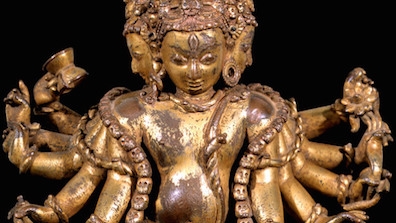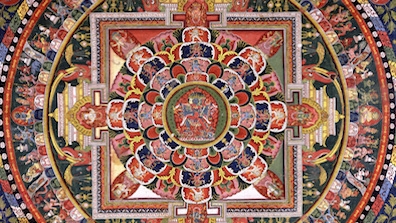
1. Do you have a personal connection to a Nepalese artwork in the collection? If so, which one?
EP: Yes, the 14th-century sculpture of Bodhisattva Avalokiteshvara. When I look at this image I think of Nepal. This form of Avalokiteshvara is one of the most popular in Nepalese culture. This sculpture itself displays most recognizable characteristics of Nepalese art of that time evident in the figure’s graceful stance and elegant proportions, typical rendering of the face with a slightly hooked nose, and simple but detailed adornments and ornaments.

2. Historically, what have been the most common/popular art forms in Nepal?
EP: Nepal is known for its exceptional tradition of creating sculpture in metal and wood, as well as traditional painting on cloth, called pauba. Popular art forms in Nepal also include arts of performance, such as music and dance. Nepal has many festivals, in which communities come together to celebrate important seasonal changes that affect their daily lives and traditionally everyone would participate in them in any capacity they are able.
*These festivals include Gai Jatra, an annual event honoring those who passed away during the year.
3. What are some artistic traditions (painting, metalwork, sculpture) or processes that are unique to Nepalese art?
EP: Nepalese artists were famous for their metal sculptures, which they created and still create in repousse and cast metal, often gilded. The technology of making such sculptures of different scale was not unique to Nepal but Nepalese artists developed exceptional skills in both and were the main sources for producing images for local commissions and abroad, most notably for Tibetan as well Chinese patrons.
4. Which regions in Nepal are best known for their artistic output?
EP: The most famous center of artistic production is Kathmandu valley and the three cities of Bhaktaphur, Patan, and Kathmandu that used to be city states in ancient times but now are part of a larger urban area in the valley, somewhat similar to the boroughs of New York.
Carousel Images: Bhairava (detail); Nepal; 14th century; Copper alloy with inlays of semiprecious stones; Rubin Museum of Art C2003.33.1 (HAR 65256). Mandala of Chakrasamvara (detail); Nepal; 19th century; Pigments on cloth; Rubin Museum of Art Gift of Shelley and Donald Rubin C2006.66.44 (HAR 100012).
Add Your Thoughts
Comments are moderated, and will not appear on this site until the Rubin has approved them.


